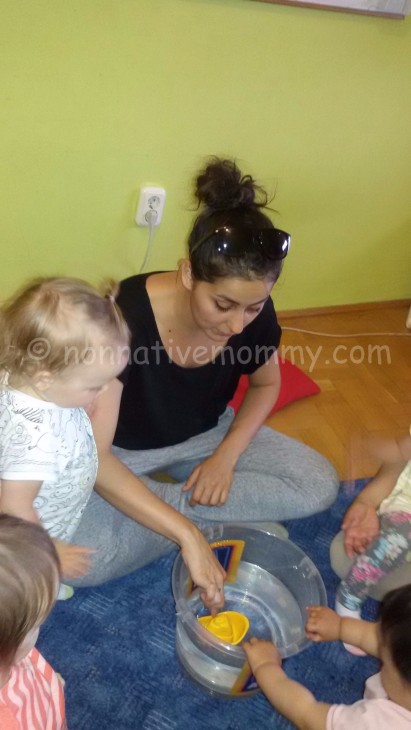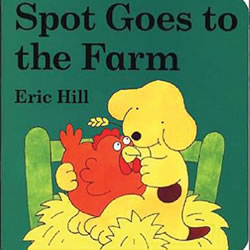While E. was having fun in her summer camp at our Helen Doron School, Baby L. took part in her very first Baby Days. There are 6 days this year (3 + 2 day within 2 weeks) but we could go to only 5. The days are organised around topics and the teaching materials are made up of HD (Helen Doron) course material and the teacher’s own ideas.
Day 1 – Vehicles
There were a great variety of vehicles during our 45 min lesson:
car, bus, plane, helicopter, police car, sailing boat, paddle boat, bicycle, train, submarine (!) backhoe (wow), ambulance, canoe and some I forgot…
I found it a little too many for such small kids, but they didn’t mind at all, what’s more ever since the lesson L. is pointing at every vehicle and says: “auto” (car) or shows the sign of the train. On the way home she wanted to get on the bus. So I can say she was captivated with vehicles.

There were plenty of fun activities:
-what’s missing
-match the vehicle to the place it belongs (bus-road, train-tracks, ambulance-hospital, backhoe-building site etc.)
-drive a car yourself
-drive your car on the road (road carpet and many matchboxes)
-what’s in my bag? (pulling out a lot of toy vehicles)
-ship in the water

-make the frog sit in the vehicle

-fit in the vehicle in the wooden puzzle
-place your vehicle in the city

And of course, bubble blowing and dancing couldn’t have been left out.
Day 2 – Fruits, colours (painting)
Again an action packed day with fruits and colours.
Pulling things out of a bag or a hat is always fun for little hands.
Putting the the fruit on the right colours was a challenge for everyone.

A big tray of fruit to tastes. An array of colours. L. was attracted to the banana slices only. What a pity!

Painting is a messy business with such tiny kids. But our teacher took the risk and it was real entertainment for the little ones.

Day 3 – Animals
There was quite a lot of revision at the beginning of the lesson: colours, fruits and vehicles. The best revision game was when different fruits were stuck on the IKEA peg and hammer toy. Kids needed to choose a fruit and hammer it, naturally with the help of an adult. But the main focus for today was animals, mainly forest animals.

We started with some well-known animal flashcards (dog, frog, kangaroo, cat etc.) then Z., our teacher, introduced the new ones (owl, raccoon, bear, fox, deer) together with some plants (mushroom, flower, tree). The bingo card was acute way to practice them but L. was more interested in the bead manipulatives.
Next, we had a little colour revisions with mushrooms, then we got some really colourful, fluffy and thick pipe cleaners to tickle different body parts.

Some more matching of rabbits and foxes and the Goodbye song started… too soon.
Day 4 – Family
There was a change in the teacher (our teacher was taking a break) so the lesson was little different but still fun. The focus was on revision rather than the main topic: family members.
The following activities took place:
- puzzles with colours and fruit/veggies

- pulling and identifying soft fruit and veggies from a hat
- sorting vehicles according to their colours
- stamping on coloured paper
- swinging with family members
- adding the missing family members to the right family

Of course, there were a lot of singing and dancing as usual. Our little group mates changed a bit but L. didn’t mind it the least bit. It’s true that she was a little more interested in other things, like pillows and cars she’d found than some of the activities.
Day 5 – Feelings (and body parts on the face)
On our last day we had plenty of funny, smiley and sad faces to L.’s great delight. There was very little revision, which we did not mind at all.
We started with the element of surprise 🙂
Our teacher, Sz., pulled out some surprising objects from a bag. A ball that could be extended, a plush hammer that said “bang” when kids hit with it, a cat that said miaow, a singing monkey, a very bouncy ball, 2 surprise eggs and a jack-in the box kinda cow. All the children’s jaws dropped open.
Next, we got some paper plate faces the mouth of which could be turned round showing either a happy or a sad face. Our teacher used glad and unhappy instead of saying happy or sad.
A mirror appeared and the kids could look at themselves, which they really enjoyed. They could place kissy lips or a moustache in front of their mouths. They didn’t really want to, though. Two eyebrows could be drawn on kids’ forehead, whoever wanted. L. got some heat rash on her face so we rather stayed away from the face-paint.
The following game was a puzzle made out of paper plate. Everybody got a different emotion.

Then came the funniest part. Sticking eyes, nose, lips, moustache, ears, hair, on a head shaped image. We really had fun making funny faces. I made one sleeping face as L. is fascinated by a sleeping face.

After that a little counting. Counters (beads) needed to be places on the jumping monkeys.
Some revision of family members. Kids placed the missing animal from the given family sheet.
We finished the session with some grapes tasting and black pepper smelling (these two are connected to a HD song that we, of course, sang afterwards). I wasn’t very happy with this activity. The grapes were not cut in half and after sniffing into black pepper L. kept on sneezing. Just for your information, no kids were harmed during our session 😉
We’ve had lots of fun nicely spread throughout 2 weeks. If you have a chance to try baby days at a HD school I encourage you to give it a try.

















































